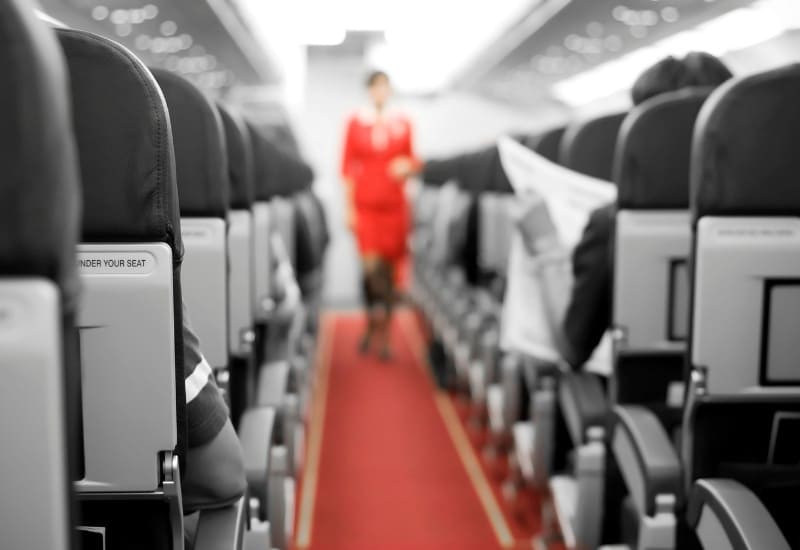One of the main parts of any flight attendant interview are the scenario questions. These questions are designed to give recruiters an understanding of how you would choose to handle tricky situations at 30,000 feet.
To help you prepare for these kinds of questions we have prepared some examples of the most common scenario questions, and given you examples of appropriate answers.
Related read: 70 Real-Life Flight Attendant Interview Questions
Scenario 1: The Diaper Dilemma
Here’s the scenario: You are in the middle of a meal service when a passenger tries to hand you a soiled baby diaper. She asks if you can dispose it for her. What would you do?
Why this scenario: This particular scenario is testing your ability to balance customer service with the sanitation standards you have to hold yourself to.
Context: It is a rule that you cannot handle bodily fluids of any kind (diaper, sick bags, etc.) while serving food, but at the same time you want to assist the passenger.
Answer: The best way to handle this situation is to inform the passenger that you can dispose of the soiled diaper for her, but only after you have completed the meal service, otherwise she is more than welcome to dispose of it herself in any of the on-board lavatories.
Bonus: You should also instruct the passenger to place the soiled diaper into a sick bag before disposal.
Scenario 2: A Few Too Many (Drinks)
Here’s the scenario: You are working a long-haul flight and have been serving alcohol to passengers. One has clearly had too many and is now becoming disruptive towards other passengers. He flags you down and asks for another drink. What would you do?
Why this scenario: This scenario is unfortunately very common, so you must know how to handle it.
Context: It is actually a flight regulation that you cannot let passengers get drunk. This is because they often become belligerent, which can jeopardize the safety and security of the rest of the flight. Additionally, intoxicated passengers could become a hazard in the event of an evacuation since alcohol impairs their ability to react quickly and appropriately in an emergency.
Answer: In this case, you must cut the passenger off. However, you also have to be able to do this with the right tact, because you could anger the passenger, (especially if they have history of addiction).
The best way is to simply explain the regulation, “I apologize, but I am only permitted to serve you X number of drinks per fight, but I am happy to offer you another beverage, perhaps a soda or a juice?”
Whatever you do keep the way you put it impersonal. Make it about the regulations, rather than the passenger’s drunkenness.
Scenario 3: The Kneeling Nelly
Here’s the scenario: Your flight has just finished boarding and you are preparing to close the door and push back when a passenger gets out of their seat and kneels in the aisle. You ask them to return to their seat and fasten his seatbelt, but they insist that they must continue to pray. What would you do?
Why this scenario: This question is testing your ability to balance cultural sensitivity with a firm adherence to your airline’s regulations.
Context: Before you are able to close the boarding door and taxi, all passengers must be seated.
Answer: You can start by reiterating to the passenger that they have to return to their seat for the safety of the others on board the flight. Kindly let them know they can resume their prayers as soon as the aircraft has reached a safe cruising altitude.
If this is not enough to persuade the passenger let them know that, due to airline policy, they will have to deplane if they wish to continue, because they would otherwise be delaying everyone else on board by preventing the airplane from departing. Appeal to their sense of courtesy towards others and make it clear you want to accommodate them but given the phase of flight, your options to do so are limited.
Scenario 4: The Petty Passenger and the Silly Snorer
Here’s the scenario: You are working a night flight when a passenger in 38B complains that the passenger in 39 B is snoring too loudly. They want you to make them stop. What would you do?
Why this scenario: This scenario tests your ability to balance the comfort of multiple passengers whose needs are in conflict with one another.
Context: Passengers often make these kinds of requests, and it is your job to manage passenger expectations and act as a mediator when one passenger’s needs directly impact another’s. You have to somehow make sure everyone ends up happy(ish).
Answer: The first thing to do is empathize with the passenger who finds the other one’s snoring annoying. Let them know you understand why they’re frustrated and validate their feelings. Then offer them a solution that does not involve waking the other passenger. You can offer them a pair of earplugs, or headphones. If that isn’t acceptable, you can try to see if there is an open seat further away from the snoring passenger.
If it were me, I’d say something along the lines of, “Oh, you know, I also find it hard to sleep when someone is snoring. Although I won’t be waking anyone up, let’s see if we can find a solution that will make everyone comfortable…”
Scenario 5: The Grinder
Here’s the scenario: You are doing your pre-takeoff cabin safety check and you notice a passenger busily typing away on their laptop. You ask them to turn it off and stow it for take-off, but they rudely snap back that their work is important, and inform you that, “the flight attendant on my last flight let me do it”. What would you do?
Why this scenario: This scenario is designed to test how you would respond to direct confrontation by a passenger.
Context: Passengers these days, (especially in the US), are increasingly unwilling to comply with instructions from flight crew. The FAA has reported a record number of passenger non-compliance reports, and the issue is plaguing the whole industry. Unfortunately, you will run into these people almost daily.
Answer: In this situation, you have to be firm and set a boundary with the passenger. Especially if they claim they weren’t held to a particular standard on their “last” flight. In this situation, you need to politely and calmly inform them that refusal to comply is a violation of FAA regulations and can result in a fine.
If they continue to argue the next step is to involve another flight attendant or the captain to de-escalate the situation.
Bonus: Sometimes if a passenger refuses to comply with basic safety instructions I explain the natural consequences of their actions, but I don’t recommend telling a recruiter you would do this.
Scenario 6: Emotional Baggage
Here’s the scenario: A passenger tries to stow their roller board in an overhead bin. It doesn’t fit. They look at you with bewilderment and say, “But it fit on the last flight! I really don’t want to check my bag because the airline lost mine last time! Is there anywhere on the plane you can put this?” There are no big compartments on board to stow their luggage.
Why this scenario: The interviewer would like to know how you would handle a situation where a customer is flustered and in need of assistance.
Context: A lot of customers hate to be told they need to check their bag. They get worried the airline will lose it based on stories they’ve heard or past experiences. They might react with frustration and anger and sometimes be argumentative
The answer: Kindly explain to them that there is no place on the airplane for their bag, and it will have to be checked. Let them know you will personally handle their luggage with care and pass it off to the baggage handlers. Provide them with a receipt of the tag.
Bonus: Let the gate agent know that this passenger is particularly anxious about their bag being checked and to double-check that their bag was loaded properly.
Scenario 7: Wild Child
Here’s the scenario: The flight attendant’s call button goes off during service. You walk over to find out that a passenger called you over because a child seated behind him is repeatedly kicking the back of their seat. He asks if you can move him, but it’s a full flight.
Why this scenario: The interviewer is testing your problem-solving abilities in a tricky situation.
Context: As much as some of us say, “I’d never let my kid… etc.”, there are plenty of passengers who allow their children to act unruly on flights without realizing who they are affecting around them. This can be a huge disturbance to passengers who are trying to use the flight time to relax, read or get some work done.
Answer: When confronted with a conflict where two parties are involved, the rule of thumb is to always first re-locate the passenger with the issue before moving anyone else. However, since this scenario had an added curve ball of the flight being full, that is not a possible option.
Always begin by acknowledging the passenger’s issue with empathy so they know their feelings are validated. Explain that it is a full flight so you can’t move them, but you will take care of the situation as best as possible.
Then, speak to the parent or guardian of the child. Kindly explain that the child is disturbing the people around them, and suggest possibly bringing over any extra snacks or entertainment (most airlines provide some kind of entertainment kit on board that might have coloring books, paper airplane-making kits, a deck or cards, etc.)
Bonus: A bonus option for that extra hyped child who undoubtedly ate way too many Skittles would be to suggest that one parent/guardian from the family switch seats with the passenger being disturbed and sit in front of the child so the non-family member can have relief and the parent can handle the situation from there.
Scenario 8: The Daredevil
Here’s the scenario: During cruise, the captain calls to report heavy turbulence ahead. He requests that the flight attendants take their seats and turns the seatbelt sign on. You make the appropriate seat belt sign announcement to inform the passengers that there are reports of rough air ahead, and for all passengers to return to their seats and fasten their seat belts. While the bumpy ride gets worse and worse, you spot a determined passenger making their way up the aisle to use the lavatory.
Why this scenario: The interviewer is looking to see which actions you will take in a situation where a passenger’s safety is at risk.
Context: Turbulence during flight is common, and sometimes passengers either don’t hear your announcement or just choose to ignore it. By doing this, they are at a high risk for falling and injuring themselves or those around them.
The answer: The first thing to remember is that flight attendants are “informers, not enforcers”. The second thing to remember is that you have no idea the many reasons a person could need to use the lavatory immediately.
I’ve had passengers tell me so many different personal reasons as to why they have to get up and run to the lav while the seat belt sign is on, and after hearing some of those reasons, I never challenge anyone.
The best thing to do is just to remind them that the seat belt sign is on because it’s not safe to be moving through the cabin. That’s it. If they choose to continue their journey, you have done what is required of you.
Bonus: A passenger desperately in need of relief still might ask for permission, and in that case, the best answer is, “Please be aware that the seat belt sign is on, so it is at your own risk.” It’s a loophole to cover your butt by not saying yes or no while also not making them feel like you’re trying to force them to suffer.
Scenario 9: Misconnections
Here’s the scenario: 10 minutes before initial descent, the captain calls the flight attendants to inform them that there is heavy air traffic and will be 25 minutes delayed landing at their destination. He relays this information to the passengers on the intercom.
Right away, a few call buttons go off. Passengers are worried about their connections and want to know if their planes will be held for them.
Why this scenario: The interviewer would like to see how you handle an on-the-spot customer service situation.
Context: Sometimes there is heavy traffic going into an airport. This can cause air traffic control (ATC) to require some planes to remain in a holding pattern, where they fly in a circle near the airport to delay landing in order to allow more spacing between aircraft landings.
The answer: The main thing that the passengers are looking for is communication. As tempting as it is, hiding out in the galley and eating snacks (yum) is not the answer. It’s important to show your face and get out there into the aisle to explain the situation for those who didn’t quite catch the captain’s message (there will be a lot) and to deal with any concerns.
As far as the question about missed connections, never tell the passengers yes or no for sure. We don’t really know, and that’s not our decision to make.
The safest answer is to inform the passengers that the gate agents at their gates know we are arriving delayed, and just to focus on getting over to their gate as quickly as possible without making any stops.
You should also have a report you received at the beginning of the flight (either paper or digital) that has a list of connecting flight gates. It always helps to let those anxious passengers know which gate they’re leaving out of.
Bonus: Sometimes people are not tech-savvy. Earn some brownie points by showing them where on their airline app they can look up their connecting flight status and whether or not it’s delayed as well.
Sometimes, their next flight being delayed will provide them some relief as they have more time to make it to their gate.
Scenario 10: Tech Support
Here’s the scenario: During your preflight meeting with the crew, the captain informs you that the Wi-Fi is inoperative. There will be no fixing it for the upcoming 4.5 hour flight.
Why this scenario: The interviewer is testing both your communication skills and your problem-solving abilities.
Context: Sometimes as a flight attendant, bad news has to be delivered to passengers. I know, total cringe. They are unavoidable situations, and it’s important to demonstrate that you can handle them as swiftly and efficiently as possible. Inoperative Wi-Fi means that not only will the internet and texting be unavailable, but also the inflight entertainment (movies, TV shows, games, etc.)
Answer: This information should be delivered as soon as possible, so maybe a few times during the boarding process. First deliver the news that the Wi-Fi will be off for the duration of the flight. Apologize for any inconvenience.
Suggest that the passengers use this time during boarding to download any offline media they would like to have for the flight. For example, they may want to use that time to download a new book onto their Kindle device. Also, Netflix and other streaming sites have offline content available for download.
If there are kids on board, check on them once or twice throughout the flight and see if they want any extra snacks or something from the airline-provided inflight entertainment kit.
Bonus: Frequently, there is a stack of magazines lying around that other flight attendants from previous flights collect and save for you or whoever is taking over the plane when they leave. Just for fun, offer one to a passenger who may be passing by on their way back from the lav. They may really appreciate it!
Conclusion
As flight attendants we are faced with quite a few sticky situations in-air, being able to think on your feet is a necessary skill, so it’s no wonder that airline recruiters like to ask scenario-based questions to see how you approach problem-solving.
We hope these examples of scenario questions and answers will help you stick the landing at your upcoming flight attendant interview!
Do you have any other questions or scenarios that you would like us to address? Feel free to leave a comment or question below!




If an angry passenger boards the plan and finds another passenger on his seat what would you do?
First you would listen to the angry passenger, and then ask to check the boarding ticket to be sure. If the accusing passenger was wrong, point them into the correct seat and offer them accommodations to make them feel more comfortable. Then apologize to the passenger sitting being yelled at for any inconvenience and also ask if there’s anything you can do to make them more comfortable. Be sure to thank them both for their cooperation.
However, if the man was right and the passenger is in the wrong seat after checking the angry passenger’s ticket, ask to see the ticket of the one sitting down and help them find their seat. After this is all situated, apologize for any inconvenience to the both of them and ask if there’s anything we can do to make them more comfortable. Then thank them for their cooperation.
How about the passenger complaining that he can’t connect to the wi-fi and it seems to have a problem with the connectivity of it? How should the flight attendant respond to it?
The flight attendant should say sorry and help out with the problem. They can tell the passenger to reset their device or try connecting with another one. If that doesn’t work, the flight attendant can try restarting the Wi-Fi or move the passenger to a different seat with better connection. It’s all about being kind and understanding, even if the flight attendant can’t fix everything.
How about a passenger that has to check in their carry on at the door of the aircraft because it’s a full flight and the compartments are full and the passenger states that last time he had to checked his bag at the door his bag was damaged
Hey Marcos, thanks for your question!
I would probably answer something along those lines:
“I understand your concern about the safety of your luggage. We take the utmost care to prevent any damages during the handling process. However, as today’s flight is fully booked and overhead compartments are full, we need to check in your carry-on. I assure you our ground staff are well-trained and will handle your luggage carefully. If, unfortunately, any damage occurs, our airline has policies in place to address such issues. Thank you for your understanding and cooperation.”